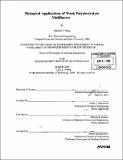| dc.contributor.advisor | Paula T. Hammond and Michael F. Rubner. | en_US |
| dc.contributor.author | Berg, Michael C., Ph. D. Massachusetts Institute of Technology | en_US |
| dc.contributor.other | Massachusetts Institute of Technology. Dept. of Chemical Engineering. | en_US |
| dc.date.accessioned | 2006-07-31T15:15:57Z | |
| dc.date.available | 2006-07-31T15:15:57Z | |
| dc.date.copyright | 2005 | en_US |
| dc.date.issued | 2005 | en_US |
| dc.identifier.uri | http://hdl.handle.net/1721.1/33599 | |
| dc.description | Thesis (Ph. D.)--Massachusetts Institute of Technology, Dept. of Chemical Engineering, 2005. | en_US |
| dc.description | Includes bibliographical references. | en_US |
| dc.description.abstract | This thesis research focused on biological applications of ultra-thin weak polyelectrolyte multilayers with specific emphasis on cell patterning, drug delivery, and antibacterial coatings. All of these very different applications were studied using three different polymers - polyacrylic acid (PAA), poly(allylamine hydrochloride) (PAH), polyacrylamide (PAAm). The first part of this thesis focuses on patterning polyelectrolyte multilayers found to resist mammalian cell adhesion, with ligands that promote specific interactions for adhesion. It was found that by patterning PAH on polyelectrolyte multilayers, the patterned functional group density and thickness could be tuned through ink pH adjustment. By changing the surface density of amine groups in the PAH patterns, the ligand density could also be altered using specific chemistry to attach peptides containing the tri-peptide sequence, RGD, which is known to promote cell adhesion in a number of cell types. The RGD density in the patterned regions determined the number of cells attached and the amount of cytoskeletal protein organization. The second part is an evaluation of porous polyelectrolyte multilayers as a delivery system for controlled release of small molecule drugs. The loading and releasing properties of porous PAH/PAA multilayers were investigated using the two drugs, ketoprofen and cytochalasin D. It was determined that the amount of drug released was proportional to the number of porous layers. Nanoporous films showed zero-order release, whereas microporous films displayed Fickian diffusion. The efficacy of the released drugs was checked by monitoring the effect of released cytochalasin D on fibroblasts' division. | en_US |
| dc.description.abstract | (cont.) In the final part of this thesis, the antibacterial properties of both silver-loaded polyelectrolyte multilayers and superhydrophobic multilayers are examined. It was found that silver loaded multilayers killed bacteria to an extent greater than 99.99% for both airborne and waterborne models. Superhydrophobic films showed excellent anti-fouling properties for proteins, mammalian cells, and bacteria. | en_US |
| dc.description.statementofresponsibility | by Michael C. Berg. | en_US |
| dc.format.extent | 156 leaves | en_US |
| dc.format.extent | 9505766 bytes | |
| dc.format.extent | 9497559 bytes | |
| dc.format.mimetype | application/pdf | |
| dc.format.mimetype | application/pdf | |
| dc.language.iso | eng | en_US |
| dc.publisher | Massachusetts Institute of Technology | en_US |
| dc.rights | M.I.T. theses are protected by copyright. They may be viewed from this source for any purpose, but reproduction or distribution in any format is prohibited without written permission. See provided URL for inquiries about permission. | en_US |
| dc.rights.uri | http://dspace.mit.edu/handle/1721.1/7582 | |
| dc.subject | Chemical Engineering. | en_US |
| dc.title | Biological applications of weal polyelectrolyte multilayers | en_US |
| dc.type | Thesis | en_US |
| dc.description.degree | Ph.D. | en_US |
| dc.contributor.department | Massachusetts Institute of Technology. Department of Chemical Engineering | |
| dc.identifier.oclc | 64035839 | en_US |
